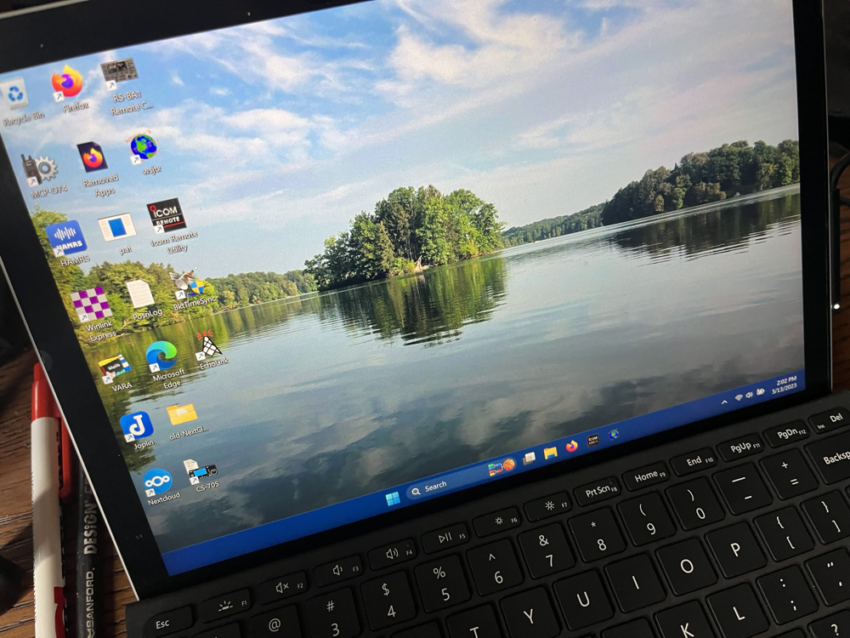The Issue:
In the world of ham radio, we have what I consider to be a bit of a problem. We have a very deep addiction to the Microsoft Windows ecosystem. Why is it a problem? Because Windows itself, in 2023, is not much better than windows 10 years ago. Which wasn’t that much better than Windows 10 years before that. I think I’ve noted my dissatisfaction with this in the past, so I won’t beat it to death (Just kidding! I totally will!).
Even the most passionate Windows enthusiast will admit that, from time to time, a device needs to have the operating system purged in some manner. In my experience, this comes down to drivers. Windows either gets attached to a driver that can no longer be used or an update to a driver goes sideways and kills some functionality. Or, in the case of my recent issues with Winlink Express and VARA HF, something somewhere takes a holiday and decides that your stuff isn’t going to work anymore and no matter how many times you uninstall and reinstall that software, it’s just not going to work.
To get around this, I’ve heard of people building out VM images and popping those in and out as needed. Great. Sure. Why not? Maintain an entire Virtual Machine library so that when your stuff breaks you can simply swap it out. How about we just have things that work? Well, we have those, but most of our ham radio software doesn’t run there. And so, here I am, watching the little blue box as my Surface Go 2 runs through the reset ritual.
Whining about Windows wasn’t the point of this post. The point is to document the software I need for the way I operate in the field and how I installed it and what I had to do to make it all work. Because, as I’ve noted in past posts, something is always just outside the available documentation. Hopefully, this will get everything that I need in one place and eliminate the need for experience based muscle memory in the configuration of the system.
The Scope:
I will be installing all of the drivers necessary to support the IC-705, the Xiegu X6100, and the Kenwood TH-D74A. All of my field software will also be installed. Not every package that I’ve ever used, but the packages that I use the most. It includes the following list.
IC-705
- IC-705 USB Driver
- CS-705 Programming Software
- RS-BA1 Version 2
X6100
TH-D74A
Core Radio Operations Software
Absolutely Critical Non-Radio Software
- NextCloud – Seriously. Are you still using cloud storage that you don’t control? I’m not.
- Joplin – Imagine a notebook that syncs across devices and operating systems without a trillion dependencies. Oh and it’s encrypted too! Snaps right into NextCloud.
Order Of Operations
Before anything can be done, NextCloud needs to be installed. That’s where I keep all of the software
The most critical piece of my setup is the IC-705. That means will starting with getting that set up and running with the programming software. Successful connections with the programming software should confirm that the USB drivers are functional. With that complete, I will move on to the RS-BA1 v2 software for remote operation and I will test that with WSJT-X. If all is well there, the bulk of what I use the Surface for in the field will be confirmed.
With the IC-705 up and running, Winlink Express and VARA HF will follow. This is the core reason for this reset. If these two play nice and Winlink email can be sent and fetched successfully, then the reset will likely be worth it.
Next up will be the drivers for the X6100. This was a serious issue the first time I installed them and I’m hoping that it’s smoother this time. Prior to the reset, I was unable to get WSJT-X to talk with the X6100. It was detected as the wrong kind of device and required a great deal of tinkering for anything to work. If the X6100 connects and can use WSJT-X, then that will signal a complete success.
With the HF rigs functionally interfacing with the Surface, the Garmin GPS unit will be paired and the BktTimeSync software installed.
The nice to have starts with the TH-D74A drivers and software. Largely this is to support adding any additional repeaters, etc. in the field. It truly is a nice to have as that can be done via the radio’s rather Byzantine UI.
Then it’s on to the bonus software. HAMRS is my preferred logging software for the field as it is SO easy to use. CW Skimmer is something I poke at once in a while. FLDIGI is something we should all have some familiarity with simply to support some useful digital modes like OLIVIA and RTTY. EchoLink should be on every computing device that a ham uses.
And now, on with the show…
The Work
IC-705 Driver
The USB driver for the IC-705 is tried and true. It was truly a click-through adventure.
CS-705 Programming Software
This software, while crude, has a solid installer and does what’s on the tin. Setup was fast and it proved to me that the USB driver was installed and functioning.
RS-BA1 Version 2
Warning: Mini-Rant Ahead
The IC-705 came into my life just as the COVID-19 pandemic was closing things down. It was a welcome relief. I was very fired up to get into the wireless lifestyle with all that could be done using the RS-BA1 software. I ran to ICOM’s site expecting to be able to run a credit card and download the packages. Oh how wrong I was! I needed to order something called a DVD-ROM.
Yeah. We’re in the 2020s and ICOM is selling software on a plastic circle. I would have thought that the shortage of plastic circles that they hit (no…really…they couldn’t ship DVDs for a time) would have pushed them to distribute software like literally everyone else in the world, but no.
To get the RS-BA1 v2 software installed again, I had to dig out an ancient relic of times past. Do you recognize the silver thing attached to the Surface?
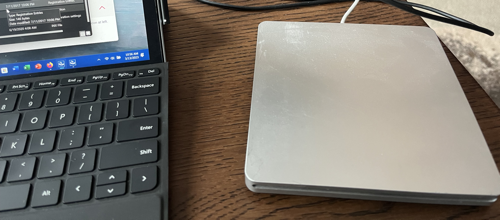
The software did install and I was able to update it. But this is a critical hole in my portable station. I am at the whim of a plastic circle. I’m sure I can clone it and have a copy handy, but seriously? This is bad news and something to be painfully aware of for the next round of reinstall. It also makes the disaster recovery list of things that have to be dealt with in short order.
WSJT-X
This package always installs smoothly. I’ve never had an issue on MacOS, Windows, or GNU/Linux distros with this one. There’s some clicking and configuring for the rig in question and then it’s off to the races. It worked right away with the remote software.
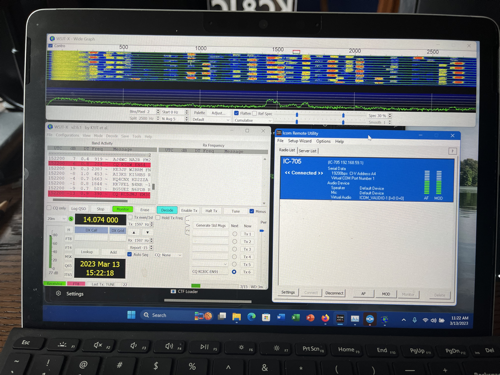
A quick round of transmissions showed that everything was on the air and the station was heard.
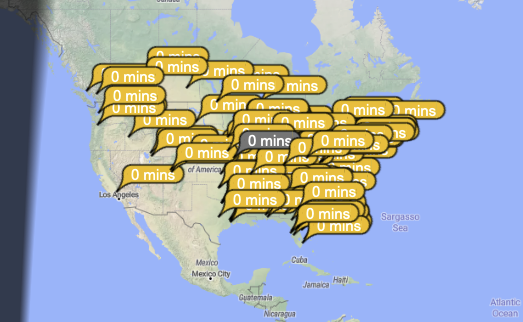
Of course this is just round one. Once the X6100 is installed, there will be a part two configuration and testing of WSJT-X.
Winlink Express / VARA HF
One of these packages doesn’t get installed without the other. Since the simpler Windows reset keeps some settings around, the license part of Winlink Express didn’t go out the window. That kept things moving. VARA HF is quite simple to configure and it all went together quickly. The first launch of a VARA HF session from Winlink Express would tell me everything.
It worked!
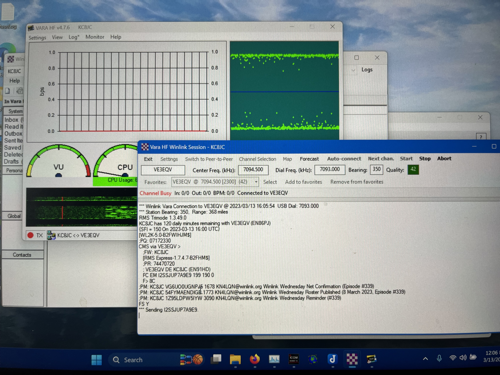
I was able to send a test message and receive three pieces of email that were waiting for me. The test message went just fine so I would say that I am back on the air with Winlink Express and VARA HF from the field. Thanks to the VE3EQV gateway for being a good host with some excellent throughput!
It is important to note that it took a Windows refresh to resolve the issue that I came across with the setup previously. That doesn’t bode well for reliability in the field given that there were no other changes to the system outside of Windows Updates. Not a good look for software that is often deployed for emergency support.
BktTimeSync
To complete field readiness for the IC-705, the final package is BktTimeSync. This piece of software allows for the synchronizing of the Windows system clock with an attached GPS. In this case, the Garmin GLO 2. The little widget is rechargeable and works well in the field. Given that it’s Bluetooth enabled, there are no additional cables for getting the right time – which is essential for modes like FT8 where everyone needs to be within about 2 seconds of one another for anything to work. Installation here was simple. Everything connected right away. Time sync’d as expected. Another green checkmark.
X6100 USB Driver
And here’s my first red flag. Or at least the first queasy feeling. Installing the driver is quite a throwback to Win95 or 3.1 days complete with directory structures drawn in ASCII art. At the completion, it said that the drivers were already installed. Now, this could be a bad translation because English is a rough language when it comes to verb tenses. Or something could be majorly screwed up. There’s really only one way to find out…
X6100 WSJT-X
My worries were for naught. The device was detected when the USB cable was attached and both the CAT and Sound ports showed up in their beautifully non-descript way. Tip: The lower COM port is the CAT control port. The higher one (or the one that shows up under an unknown device type) is the audio port. Also, testing the CAT control on the correct port with the wrong baud rate might cause the X6100 to shutdown. Which is an odd response, but OK? I guess? WSJT-X did its thing and I was able to prove that the rig was functioning as expected.
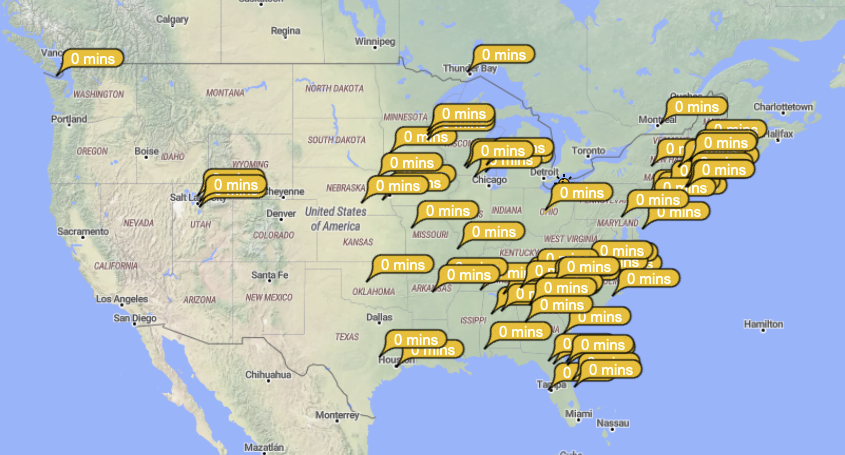
TH-D74A
The driver and MCP-D74 software both installed without issue. Pulling over the current configuration from the TH-D74 was quick and painless – as expected. This “Nice To Have” is indeed nice to have in the field.
EchoLink
EchoLink is an odd one. It doesn’t want to install to anything other than the internal disk. So it won’t go to the SD card or extended storage that is classed as removable. That’s a bit of a hassle. Aside from that, it was smooth.
FLDIGI
This one is going to have to wait. I have a ton of notes on how it was set up last time and that’s just not going to fit in the available time. On to the back burner it goes!
Conclusion
The Windows refresh was quick. That process (the Windows part of it) only ran about an hour with the “Just Get It Done” option selected. I’m sure wiping the drive and starting from scratch would have been much more time consuming. Given that users are still likely to need to refresh their systems for some time to come, it’s nice that it moves smoothly and with little interaction.
It would appear that, under controlled conditions, the refresh produced the desired results. Winlink Express/VARA HF works again. The X6100 seems to be pleased with its installation as well having passed the WSJT-X test. My field station is in better shape than it was yesterday and that’s what matters.
What’s next? I get all of this software onto some durable media as well as my NextCloud instance. Without the Internet getting back from a reinstall like this would be impossible. And that’s not great. Maybe I’ll just load up a DVD-ROM with software and…
![]()
